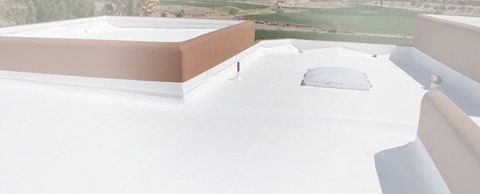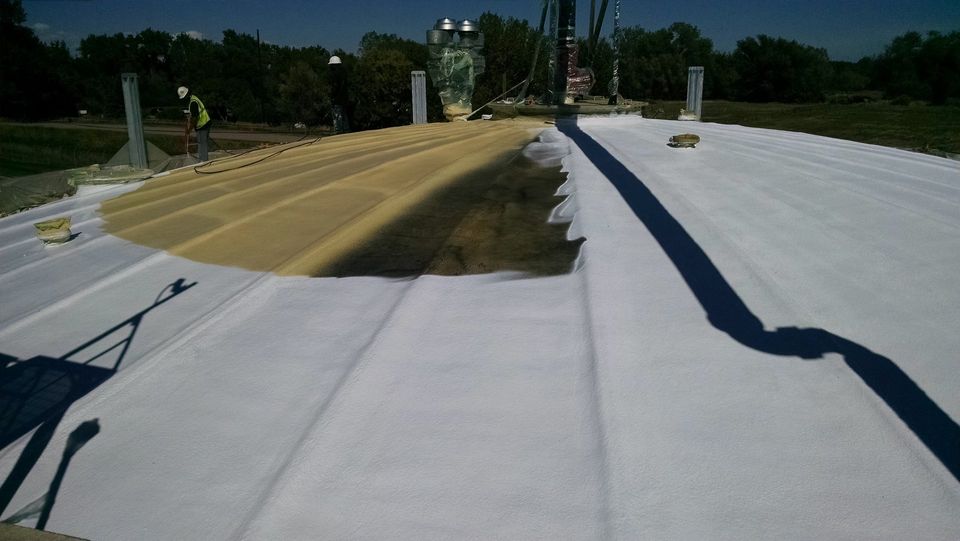Energy Efficient Roofing Since 1982


Spray Polyurethane Foam Roofing is the application of an insulating plastic, covered with an elastomeric coating material to protect the polyurethane foam from UV radiation. This roofing process is seamless, self flashing, and very cost efficient both in application and in future maintenance. Don't just take our word for it. Watch the video by clicking the photo below, or read the article that follows from one of the experts in the SPF roofing field.
Contact Us
Colorado Thermal Coatings, Inc.
Phone: 303-886-5331
Email: coloradothermalcoatings@hotmail.com
Business Hours
Mon-Sat 9 am to 5 pm
Sun by appointment.
Spray polyurethane foam roofing
What is it? How does it work?
By Mason Knowles
Oct 19, 2006
Spray polyurethane foam roofing systems have been in use since the mid-1960s and have demonstrated service life well beyond 20 years.
Spray polyurethane foam was first used commercially in the early to mid-1960s for cold storage and industrial insulation projects. Because the material is water resistant, some of the pioneer contractors experimented with applying the systems on roofs. The mid 1970s saw application and substrate preparation techniques that led to today's standards. The foam roofing experienced growing pains in two ways during its early years of use. First, although the contractors developed a high skill level in spray foam insulation application, they did not necessarily have knowledge of or skills in roofing. Some of the early premature installation failures are attributable to incorrect roofing details and techniques. Secondly, many traditional roofing contractors entered the spray polyurethane foam roofing market in the early 1970s to take advantage of the energy saving characteristics of spray polyurethane foam. Some of these contractors had insufficient training and knowledge that led to premature failure of the roofing systems they applied.
Fortunately, there emerged during this period a core group of knowledgeable and responsible contractors whose work exhibited quality and professionalism. By 1986, this core group grew into an industry guided by a national trade organization, the Polyurethane Foam Contractors Division of the Society of The Plastics Industry, Inc., recently renamed the Spray Polyurethane Foam Division (SPFD).
The SPFD formed volunteer committees comprised of engineers, scientists, contractors, suppliers, equipment manufacturers, inspectors, and material manufacturers. These committees developed over 27 technical guidelines and documents, including industry guidelines on roofing, cold storage, perimeter wall insulation, tank and vessel insulation, elastomeric coatings, position papers on thermal barriers, blisters, moisture vapor transmission, and many others.
The committees developed accreditation programs for applicators, contractors, suppliers, and inspectors. To date, over 1,700 individuals participated in the accreditation programs.
What is spray polyurethane foam?
Spray polyurethane foam roofing systems consist of an application of specifically designed covered with an elastomeric coating or aggregate covering to protect the foam from ultraviolet rays. Specialized equipment mixes two liquid components at the spray gun that applies foam to a prepared substrate. The mixed liquid expands to 30 times its original volume, forming a rigid foam plastic within 3 to 10 seconds, while chemically bonding to the surface on which it is sprayed. Spraying the foam in 1/2 to 1-1/2 inch lifts to a desired thickness (1" minimum) fills in low areas, builds in slope, and provides insulation.
Spray polyurethane foam has a closed cell structure and is water resistant. It must, however, be protected by elastomeric coatings or aggregate coverings to prevent UV-induced surface degradation. Such coverings can also be used for other purposes, including inhibiting moisture vapor transmission, enhancing the aesthetics of the system, increasing the impact and abrasion resistance of the system, achieving flammability, and code requirements.
How long does it last?
According to recent surveys, spray polyurethane foam roofing systems are highly sustainable. The oldest performing spray polyurethane foam roofs are over 30 years old.
Since the physical properties of foam changes little with age, how long the foam system lasts depends primarily on the original application and long term maintenance. Spray polyurethane foam roofs, like other roofing systems, should be inspected semiannually and after events that could cause missile damage. Small (less than 4" in diameter) dents, cracks, punctures from dropped tools, wind driven missiles can be repaired with an elastomeric caulking compatible with the foam system. Since foam adheres to itself, more extensive damage can be repaired by removing and reapplying more foam. Recoat spray polyurethane foam roofing systems covered by elastomeric coatings every 8 to 15 years, depending on a variety of factors including thickness of coating, environment, physical properties, weathering, and warranty requirements.
When is it used?
Spray polyurethane foam roofing systems have excellent adhesion to a variety of substrates including built up roofing, modified bitumen, concrete, wood, asphalt shingles, clay tile, and metal. Since they add little weight and can be applied in any thickness to add slope and fill in low areas, these roofing systems are often used as a recover roofing system over existing roof coverings.
Hail and wind driven missiles can damage the spray polyurethane foam roofing system. However, the damage does not cause leaks. Furthermore, the damage can be repaired months later without compromising the long term performance of the roofing system.
Spray polyurethane foam roofing systems also excel when the following conditions exist:
• Additional insulation is required.
• The roof substrate has numerous penetrations.
• The roof deck is an unusual shape or configuration.
• The roof is in an area where severe weather such as high winds and hail storms are likely to occur.
• Lightweight materials are required.
• Slope must be added to provide positive drainage.
Limitations:
One of the advantages of spray polyurethane foam roofing systems can also be one of its limitations. A crew of 2 to 4 persons can install spray polyurethane foam roofing systems. However, the crew must have a high degree of technical knowledge and experience in foam application including substrate preparation, roofing principles, equipment maintenance, and application skill.
Spray polyurethane foam roofing systems, incorrectly applied, most often exhibit interlaminar blistering of the spray polyurethane foam layers or coating. In many cases, trying to stretch the application window, improperly preparing substrates, or using off-ratio mixing causes this blistering.
These roofing systems, like most roofing systems, must be applied under the correct environmental conditions. The foam applicator should not proceed in ambient conditions of low temperature or high humidity. In addition, spray polyurethane foam and protective coating should not be applied when there is ice, frost, surface moisture, or visible dampness present on the surface to be covered. Barriers may be necessary if wind conditions can affect the foam quality or create overspray problems.
Investigate past performance thoroughly when selecting any roofing contractor. Spray polyurethane foam roof systems are no exception. Fortunately, every geographic region of the United States has high quality foam installation contractors.
Cost
Spray polyurethane foam roofing systems vary widely in cost depending on foam thickness, the type and thickness of covering, and the degree of substrate preparation required. As with metal and built up roofs, there are high-end and low-end foam roofing systems.
However, when taking into account life cycle and energy costs, spray polyurethane foam roofing systems become more of a bargain. According to Texas A&M with over eight million square feet of high-end foam roofing, energy cost reductions paid for the retrofit roof systems in a little over three years. Texas A&M reduced their 35-man roof maintenance crew to three people since switching to spray polyurethane foam roofing systems 10 years ago.
These roofing systems are renewable and the life cycle costs are extremely low. They are most beneficial to owners who pay their own energy costs and own the property longer.
Types of coverings
There are many types of coverings for foam roofing systems. The most common are acrylic, silicone, polyurethane elastomeric coatings, and aggregate coverings. The variety of coverings available gives a specifier options to meet specific design considerations including, but not limited to, chemical resistance, impact and abrasion resistance, aesthetic considerations, flammability and code compliance, and water vapor resistance.
These coverings perform in many climates and environments, however, there are differences in the physical properties and application requirements of each. When choosing a specific material, consider the following in your selection process.
• What was the materials performance record in a similar environment and job situation to that in which you want to install it?
• Does the manufacturer have a track record of well performing systems in your region?
• Does the contractor have experience with the covering system?
• Is there a clear advantage in terms of cost, ease of application, and performance for the covering?
• Is the covering appropriate for the performance criteria of the roof?
Also, bear in mind that covering selection affects the likelihood of condensation. For example, a foam roofing system applied to a cold storage facility requires a vapor retarder covering over the foam. Foam roofing system applied over a swimming pool requires a breathable covering on the foam. Aggregate is the most breathable covering. Acrylic and silicone coatings also are generally considered to be breather coverings. Polyurethane coatings may be relative breather or vapor retarder coverings. A thickly applied breathable coating could perform as a relative vapor retarder and a very thinly applied vapor retarder coating could perform as a relative breather.
Coatings
The coatings should be UV-resistant, elastomeric with at least 100 percent elongation, and have a minimum dry thickness of at least 25 to 30 mils. Thicker coatings meet specific job performance criteria. When recoating a spray polyurethane foam roofing system, verify that the new coating will adhere to the old coating.
Aggregate
Local availability usually determines the selection of an aggregate covering. The size of the aggregate covering is more important than the type. Use a mixture of gravel and slag sizes with the larger pieces approaching 3/4 inch. Angular flat surfaced aggregate is better than round pebbles. Cover foam with a minimum of 3/4 inch of aggregate at the rate of 500 to 600 pounds per square.
Research
Many groups including private companies, government institutions, trade groups and associations have conducted field inspections and long-term performance studies of spray polyurethane foam roofing systems for a number of years. The SPFD sponsored and evaluated much of this work to promulgate industry standards and create guidelines.
Studies currently being sponsored include: the National Roofing Foundation Joint NRCA/SPFD spray polyurethane foam roof evaluation study; Factory Mutual testing of generic spray polyurethane foam roof systems for wind uplift, hail resistance, and fire resistance; and the National Association of Home Builders' rack and shear testing of spray polyurethane foam between steel studs in metal building construction. In previous years, SPFD conducted research on the factors affecting the thermal performance of spray polyurethane foam, Underwriters Laboratory wind up lift testing, and rack and shear testing of foam applied to wood stud construction.
According to independent researchers Dr. Dean Kashiwagi, Associate Professor of Engineering at the Del E. Webb School of Construction, Arizona State University, and Dr. Rene Dupuis, of Structural Research Inc., the quality of spray polyurethane foam roofing applications increased over the last 10 years. This quality increase coincides with the efforts of SPFD to provide technical information and educational instruction for the industry.
Because of the evaluation research and the higher quality, foam roofing systems are enjoying increased market share. SPFD is developing additional education and training programs to help maintain the quality during this period of anticipated growth.
Resources for more information:
A number of technical publications relating to sprayed polyurethane foam are available. The following guidelines and technical documents specifically relate to spray polyurethane foam roofing systems:
• AY 102 A Guide for Selection of Protective Coating Over Sprayed Polyurethane Foam Roofing Systems
• AY 104 Spray Polyurethane Foam Systems for New and Remedial Roofing
• AY 110 Spray Polyurethane Foam Aggregate Systems for New and Remedial Roofing
• AY 122 The Renewal of Spray Polyurethane Foam and Coating Roof Systems
• AY 127 Maintenance Manual for Spray Polyurethane Foam Roof System.
The following documents are also available from other organizations and include information furnished by SPFD and other sources.
• AIA Master Spec on Spray Polyurethane Foam Roofing
• ASTM Standard Guide for Application of New Spray Applied Polyurethane Foam and Coated Roofing Systems
• CSI Monograph on Spray Polyurethane Foam Roofing
• NRCA Waterproofing Manual, Spray Polyurethane Foam Roof Section
• NRCA Materials Guide
What is it? How does it work?
By Mason Knowles
Oct 19, 2006
Spray polyurethane foam roofing systems have been in use since the mid-1960s and have demonstrated service life well beyond 20 years.
Spray polyurethane foam was first used commercially in the early to mid-1960s for cold storage and industrial insulation projects. Because the material is water resistant, some of the pioneer contractors experimented with applying the systems on roofs. The mid 1970s saw application and substrate preparation techniques that led to today's standards. The foam roofing experienced growing pains in two ways during its early years of use. First, although the contractors developed a high skill level in spray foam insulation application, they did not necessarily have knowledge of or skills in roofing. Some of the early premature installation failures are attributable to incorrect roofing details and techniques. Secondly, many traditional roofing contractors entered the spray polyurethane foam roofing market in the early 1970s to take advantage of the energy saving characteristics of spray polyurethane foam. Some of these contractors had insufficient training and knowledge that led to premature failure of the roofing systems they applied.
Fortunately, there emerged during this period a core group of knowledgeable and responsible contractors whose work exhibited quality and professionalism. By 1986, this core group grew into an industry guided by a national trade organization, the Polyurethane Foam Contractors Division of the Society of The Plastics Industry, Inc., recently renamed the Spray Polyurethane Foam Division (SPFD).
The SPFD formed volunteer committees comprised of engineers, scientists, contractors, suppliers, equipment manufacturers, inspectors, and material manufacturers. These committees developed over 27 technical guidelines and documents, including industry guidelines on roofing, cold storage, perimeter wall insulation, tank and vessel insulation, elastomeric coatings, position papers on thermal barriers, blisters, moisture vapor transmission, and many others.
The committees developed accreditation programs for applicators, contractors, suppliers, and inspectors. To date, over 1,700 individuals participated in the accreditation programs.
What is spray polyurethane foam?
Spray polyurethane foam roofing systems consist of an application of specifically designed covered with an elastomeric coating or aggregate covering to protect the foam from ultraviolet rays. Specialized equipment mixes two liquid components at the spray gun that applies foam to a prepared substrate. The mixed liquid expands to 30 times its original volume, forming a rigid foam plastic within 3 to 10 seconds, while chemically bonding to the surface on which it is sprayed. Spraying the foam in 1/2 to 1-1/2 inch lifts to a desired thickness (1" minimum) fills in low areas, builds in slope, and provides insulation.
Spray polyurethane foam has a closed cell structure and is water resistant. It must, however, be protected by elastomeric coatings or aggregate coverings to prevent UV-induced surface degradation. Such coverings can also be used for other purposes, including inhibiting moisture vapor transmission, enhancing the aesthetics of the system, increasing the impact and abrasion resistance of the system, achieving flammability, and code requirements.
How long does it last?
According to recent surveys, spray polyurethane foam roofing systems are highly sustainable. The oldest performing spray polyurethane foam roofs are over 30 years old.
Since the physical properties of foam changes little with age, how long the foam system lasts depends primarily on the original application and long term maintenance. Spray polyurethane foam roofs, like other roofing systems, should be inspected semiannually and after events that could cause missile damage. Small (less than 4" in diameter) dents, cracks, punctures from dropped tools, wind driven missiles can be repaired with an elastomeric caulking compatible with the foam system. Since foam adheres to itself, more extensive damage can be repaired by removing and reapplying more foam. Recoat spray polyurethane foam roofing systems covered by elastomeric coatings every 8 to 15 years, depending on a variety of factors including thickness of coating, environment, physical properties, weathering, and warranty requirements.
When is it used?
Spray polyurethane foam roofing systems have excellent adhesion to a variety of substrates including built up roofing, modified bitumen, concrete, wood, asphalt shingles, clay tile, and metal. Since they add little weight and can be applied in any thickness to add slope and fill in low areas, these roofing systems are often used as a recover roofing system over existing roof coverings.
Hail and wind driven missiles can damage the spray polyurethane foam roofing system. However, the damage does not cause leaks. Furthermore, the damage can be repaired months later without compromising the long term performance of the roofing system.
Spray polyurethane foam roofing systems also excel when the following conditions exist:
• Additional insulation is required.
• The roof substrate has numerous penetrations.
• The roof deck is an unusual shape or configuration.
• The roof is in an area where severe weather such as high winds and hail storms are likely to occur.
• Lightweight materials are required.
• Slope must be added to provide positive drainage.
Limitations:
One of the advantages of spray polyurethane foam roofing systems can also be one of its limitations. A crew of 2 to 4 persons can install spray polyurethane foam roofing systems. However, the crew must have a high degree of technical knowledge and experience in foam application including substrate preparation, roofing principles, equipment maintenance, and application skill.
Spray polyurethane foam roofing systems, incorrectly applied, most often exhibit interlaminar blistering of the spray polyurethane foam layers or coating. In many cases, trying to stretch the application window, improperly preparing substrates, or using off-ratio mixing causes this blistering.
These roofing systems, like most roofing systems, must be applied under the correct environmental conditions. The foam applicator should not proceed in ambient conditions of low temperature or high humidity. In addition, spray polyurethane foam and protective coating should not be applied when there is ice, frost, surface moisture, or visible dampness present on the surface to be covered. Barriers may be necessary if wind conditions can affect the foam quality or create overspray problems.
Investigate past performance thoroughly when selecting any roofing contractor. Spray polyurethane foam roof systems are no exception. Fortunately, every geographic region of the United States has high quality foam installation contractors.
Cost
Spray polyurethane foam roofing systems vary widely in cost depending on foam thickness, the type and thickness of covering, and the degree of substrate preparation required. As with metal and built up roofs, there are high-end and low-end foam roofing systems.
However, when taking into account life cycle and energy costs, spray polyurethane foam roofing systems become more of a bargain. According to Texas A&M with over eight million square feet of high-end foam roofing, energy cost reductions paid for the retrofit roof systems in a little over three years. Texas A&M reduced their 35-man roof maintenance crew to three people since switching to spray polyurethane foam roofing systems 10 years ago.
These roofing systems are renewable and the life cycle costs are extremely low. They are most beneficial to owners who pay their own energy costs and own the property longer.
Types of coverings
There are many types of coverings for foam roofing systems. The most common are acrylic, silicone, polyurethane elastomeric coatings, and aggregate coverings. The variety of coverings available gives a specifier options to meet specific design considerations including, but not limited to, chemical resistance, impact and abrasion resistance, aesthetic considerations, flammability and code compliance, and water vapor resistance.
These coverings perform in many climates and environments, however, there are differences in the physical properties and application requirements of each. When choosing a specific material, consider the following in your selection process.
• What was the materials performance record in a similar environment and job situation to that in which you want to install it?
• Does the manufacturer have a track record of well performing systems in your region?
• Does the contractor have experience with the covering system?
• Is there a clear advantage in terms of cost, ease of application, and performance for the covering?
• Is the covering appropriate for the performance criteria of the roof?
Also, bear in mind that covering selection affects the likelihood of condensation. For example, a foam roofing system applied to a cold storage facility requires a vapor retarder covering over the foam. Foam roofing system applied over a swimming pool requires a breathable covering on the foam. Aggregate is the most breathable covering. Acrylic and silicone coatings also are generally considered to be breather coverings. Polyurethane coatings may be relative breather or vapor retarder coverings. A thickly applied breathable coating could perform as a relative vapor retarder and a very thinly applied vapor retarder coating could perform as a relative breather.
Coatings
The coatings should be UV-resistant, elastomeric with at least 100 percent elongation, and have a minimum dry thickness of at least 25 to 30 mils. Thicker coatings meet specific job performance criteria. When recoating a spray polyurethane foam roofing system, verify that the new coating will adhere to the old coating.
Aggregate
Local availability usually determines the selection of an aggregate covering. The size of the aggregate covering is more important than the type. Use a mixture of gravel and slag sizes with the larger pieces approaching 3/4 inch. Angular flat surfaced aggregate is better than round pebbles. Cover foam with a minimum of 3/4 inch of aggregate at the rate of 500 to 600 pounds per square.
Research
Many groups including private companies, government institutions, trade groups and associations have conducted field inspections and long-term performance studies of spray polyurethane foam roofing systems for a number of years. The SPFD sponsored and evaluated much of this work to promulgate industry standards and create guidelines.
Studies currently being sponsored include: the National Roofing Foundation Joint NRCA/SPFD spray polyurethane foam roof evaluation study; Factory Mutual testing of generic spray polyurethane foam roof systems for wind uplift, hail resistance, and fire resistance; and the National Association of Home Builders' rack and shear testing of spray polyurethane foam between steel studs in metal building construction. In previous years, SPFD conducted research on the factors affecting the thermal performance of spray polyurethane foam, Underwriters Laboratory wind up lift testing, and rack and shear testing of foam applied to wood stud construction.
According to independent researchers Dr. Dean Kashiwagi, Associate Professor of Engineering at the Del E. Webb School of Construction, Arizona State University, and Dr. Rene Dupuis, of Structural Research Inc., the quality of spray polyurethane foam roofing applications increased over the last 10 years. This quality increase coincides with the efforts of SPFD to provide technical information and educational instruction for the industry.
Because of the evaluation research and the higher quality, foam roofing systems are enjoying increased market share. SPFD is developing additional education and training programs to help maintain the quality during this period of anticipated growth.
Resources for more information:
A number of technical publications relating to sprayed polyurethane foam are available. The following guidelines and technical documents specifically relate to spray polyurethane foam roofing systems:
• AY 102 A Guide for Selection of Protective Coating Over Sprayed Polyurethane Foam Roofing Systems
• AY 104 Spray Polyurethane Foam Systems for New and Remedial Roofing
• AY 110 Spray Polyurethane Foam Aggregate Systems for New and Remedial Roofing
• AY 122 The Renewal of Spray Polyurethane Foam and Coating Roof Systems
• AY 127 Maintenance Manual for Spray Polyurethane Foam Roof System.
The following documents are also available from other organizations and include information furnished by SPFD and other sources.
• AIA Master Spec on Spray Polyurethane Foam Roofing
• ASTM Standard Guide for Application of New Spray Applied Polyurethane Foam and Coated Roofing Systems
• CSI Monograph on Spray Polyurethane Foam Roofing
• NRCA Waterproofing Manual, Spray Polyurethane Foam Roof Section
• NRCA Materials Guide




